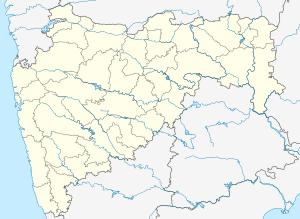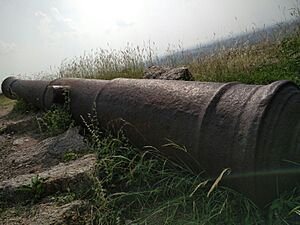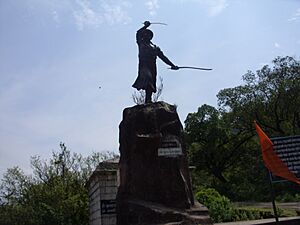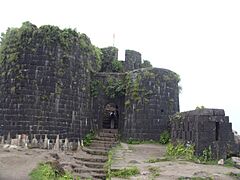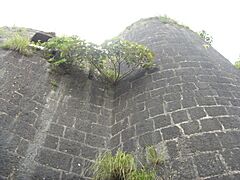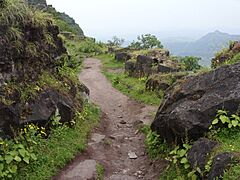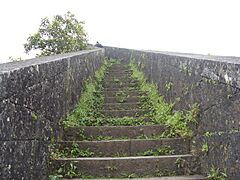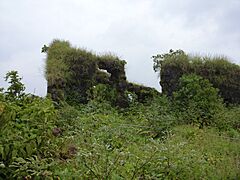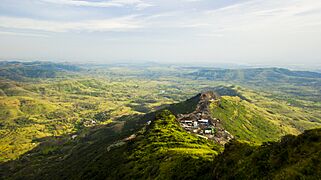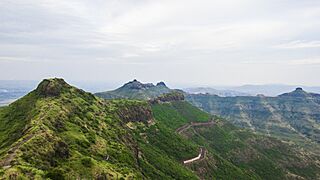Purandar Fort facts for kids
Quick facts for kids Purandar Fort |
|
|---|---|
| Pune district, Maharashtra | |
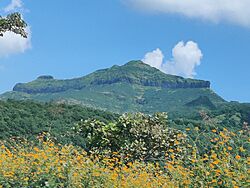
Purandhar Fort
|
|
| Coordinates | 18°16′50.8″N 73°58′25″E / 18.280778°N 73.97361°E |
| Type | Hill fort |
| Height | 1,374 metres (4,508 ft) |
| Site information | |
| Owner | Government of India |
| Open to the public |
Yes |
| Condition | Ruins |
| Site history | |
| Materials | Stone |
Purandar Fort is an old mountain fort located in the Pune district of Maharashtra, India. It stands very high up, about 1,374 meters (4,508 feet) above sea level, in the Western Ghats mountains. The fort is about 50 kilometers (31 miles) southeast of the city of Pune.
Purandar Fort is actually a twin fort, with a smaller fort called Vajragad (or Rudramal) nearby. Vajragad is on the eastern side and is also very high up, about 1,347 meters (4,419 feet) above sea level. The village of Purandar is named after this fort. A very important historical figure, Chatrapati Sambhaji Maharaj, was born here.
Contents
The Fort's Long History
The first records of Purandar Fort go back to the 11th century. At that time, it was part of the Yadava dynasty.
Early Rulers and Changes
After the Yadavas were defeated, the area around the fort was taken over by new rulers. These new rulers made Purandar Fort even stronger around the year 1350 AD.
During the early rule of the Bijapur and Ahmednagar kingdoms, Purandar Fort was directly controlled by the government. It was not given to local chiefs called Jagirdars.
Shivaji Maharaj and the Maratha Empire
In 1596 AD, the area of "Pune" and "Supa" was given to Maloji Bhosale. He was the grandfather of Shivaji Maharaj. Purandar Fort was part of this land.
In 1646 AD, a young Shivaji Maharaj took control of the fort. This was one of his first big wins for the Maratha Empire.
The Siege of Purandar Fort
In 1665 AD, the fort was attacked by the forces of Aurangzeb, the Mughal emperor. The Mughal army was led by Jai Singh II and Diler Khan.
Murarbaji Deshpande, who was the killedar (keeper) of the fort, fought very bravely against the Mughal forces. He even lost his life trying to protect the fort.
Because of this strong attack, Shivaji Maharaj decided to sign a peace agreement. This was called the First Treaty of Purandar in 1665. In this treaty, Shivaji gave twenty-three forts, including Purandar, to Aurangzeb. He also gave up land that brought in a lot of money.
Recapturing the Fort
The peace did not last long. In 1670 AD, just five years later, Shivaji Maharaj fought against Aurangzeb again. He successfully recaptured Purandar Fort.
Under the Peshwa Rule
When the Peshwas ruled, Purandar Fort was a strong base. It was used to protect their capital city of Pune when it was attacked.
In 1776 AD, another treaty was signed. This was between the British Raj and the Maratha States. It was known as the Second Treaty of Purandar. However, its terms were never fully carried out.
British Control of the Fort
In 1818, a British army led by General Pritzler attacked Purandar Fort. On March 14, 1818, the British took over Vajragad, the smaller fort nearby. Since Vajragad overlooked Purandar, the fort's commander had to surrender. The British flag was raised at Purandar on March 16, 1818.
During the British Raj, the fort was used as a prison. During World War II, it was a camp for German families who were considered "enemy aliens." Some Jewish people from Germany were also held there. A German prisoner named Dr. H. Goetz studied the fort during his time there and later wrote a book about it. The fort was also used as a place for British soldiers to recover from illness, like a hospital.
Ancient Temple at the Base
At the base of the fort, in the village of Narayanpur, there is a very old temple. It is called the Narayaneshwar temple and was built by the Yadava dynasty a thousand years ago. It is made in the Hemadpanti architecture style.
It is believed that Purandar is a piece of the Dronagiri Parvat. This is the mountain that Hanuman carried in the ancient Indian story, the Ramayana.
Exploring Purandar Fort's Structures
Purandar Fort has two main levels.
The Lower Level: Machi
The lower part of Purandar is called the machi. To the north of the machi is a flat area. This area once had a military camp and a hospital.
There are several temples on the machi. One is dedicated to Purandareshwar, who is the fort's special god. The fort is named after him. There is also a temple for Sawai Madhavrao Peshwa.
You can also see a statue of Murarbaji Deshpande here. He was the brave commander who died protecting the fort from the Mughals. The northern part of the machi has strong walls with several bastions (towers) and a large gate with two towers.
The Upper Level: Ballekilla
From the lower machi, a staircase leads up to the higher level. This upper part is called Ballekilla.
The first structure you see on the Ballekilla is the Dilli Darwaja (Delhi Gate). This area also has a very old Kedareshwar (Shiva) temple. The Ballekilla is surrounded by steep drops on three sides, making it very hard to attack.
What is Purandar Fort Used for Today?
Today, Purandar Fort is a popular place for tourists to visit. It is also used by the National Cadet Corps academy for training. The fort is a great spot for people who enjoy paragliders and trekking.
Gallery of Purandar Fort
Images for kids
See also
- Chivhe Koli
- List of forts in Maharashtra



